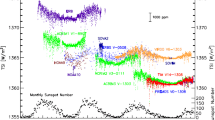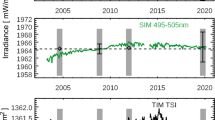Abstract
The unique advantages of space observations are recalled, and the difficulties in performing reliable measurements of solar variability from space are stressed. The elements of a strategy aimed at improving the accuracy of absolute as well as relative measurements are given.
We show with more details how space observations are crucial in determining the causes, the amplitude and the previsions of solar variability. We show how they would permit to gain a better view of the solar interior, of the origin and of the effects of the solar magnetic field. Is the quiet Sun constant? Is the magnetic flux constant? The answer to these questions is likely to be given by space experiments. We state that the understanding of solar variability and its prediction is an extremely difficult and ambitious task which will take a long time.
It is urgent that space agencies realize this and start as soon as possible a long term program for measuring the solar constant and the spectral irradiance in various spectral regimes.
Similar content being viewed by others
References
Bonnet, R. M., Bruner, E. C., Acton, L. W., Brown, W. A., and Decaudin, M.: 1980a, Astrophys. J. 237, L47.
Bonnet, R. M., Bruner, E. C., Acton, L. W., Brown, W. A., and Decaudin, M.: 1980b, in preparation.
Brueckner, G. E.: 1980, The Variability of the Sun's Ultra-Violet Radiation, XXIIIrd Cospar Plenary Meeting, June 1980, Budapest.
Delaboudinière, J. P., Fieffe-Prevot, P., Schmidtke, G., and Simon, P.: 1976, LPSP Report S-76.
Fossat, E., Grec, G., and Pomerantz, M.: 1981, Solar Phys. 74, 59 (this volume).
Foukal, P. and Vernazza, J.: 1979, Astrophys. J. 234, 707.
Golub, L., Davis, J. M., and Krieger, S.: 1979, Astrophys. J. 229, L145.
Heath, D. F.: 1980, in R. Kandel (ed.), Sun and Climate, Proceedings of CNRS/DGRST/CNES Conference, p. 163.
Howard, R. and LaBonte, B. J.: 1981, Solar Phys. 74, 131 (this volume).
Huber, M. C.: 1981, Solar Phys. 74, 539 (this volume).
Huber, M. C. E., Dupree, A. K., Goldberg, L., Noyes, R. W., Parkinson, W. H., Reeves, E. M., and Withbroe, G. L.: 1973, Astrophys. J. 183, 289.
Linsky, J. L.: 1977, in O. R. White (ed.), The Solar Output and Its Variation, Colorado Associated University Press, Boulder, Colo., p. 477.
Madden, R. P.: 1978, Space Res. XVIII, 103.
Maurette, M.: 1980, private communication.
Muller, E. A., Kneubühl, F. K., Rast, J., and Stettler, P.: 1980, Astron. Astrophys. 87, L3.
Schmidtke, G.: 1978, Planetary Space Sci. 26, 347.
Simon, P.: 1978, Planetary Space Sci. 26, 355.
Skumanich, A. and Eddy, J.: 1980, in R. M. Bonnet and A. Dupree (eds.), Solar Phenomena in Stars and Stellar Systems, D. Reidel Publ. Co., Dordrecht, Holland, p. 349.
Willson, R. C.: 1981, Solar Phys. 74, 217 (this volume).
Zirker, J.: 1980, in R. M. Bonnet and A. Dupree (eds.), Solar Phenomena in Stars and Stellar Systems, D. Reidel Publ. Co., Dordrecht, Holland, p. 301.
Author information
Authors and Affiliations
Additional information
Proceedings of the 14th ESLAB Symposium on Physics of Solar Variations, 16–19 September 1980, Scheveningen, The Netherlands.
Rights and permissions
About this article
Cite this article
Bonnet, R.M. The role of space techniques in the understanding of solar variability. Sol Phys 74, 485–501 (1981). https://doi.org/10.1007/BF00154532
Issue Date:
DOI: https://doi.org/10.1007/BF00154532




